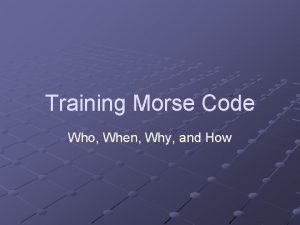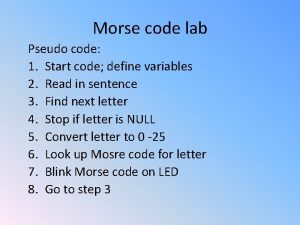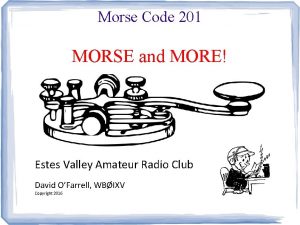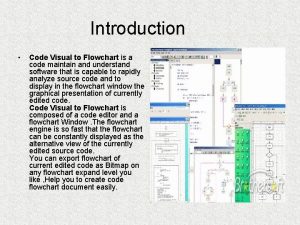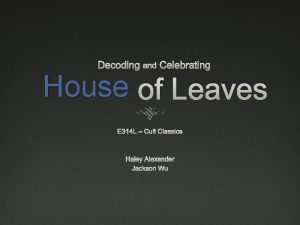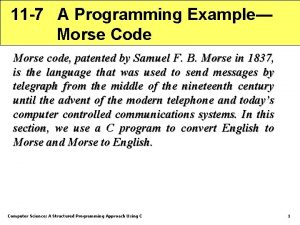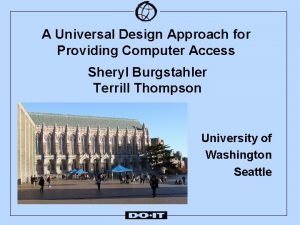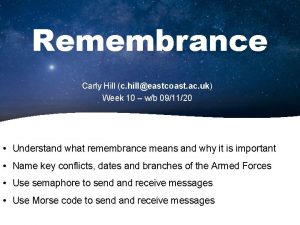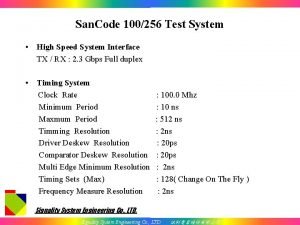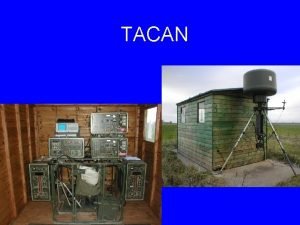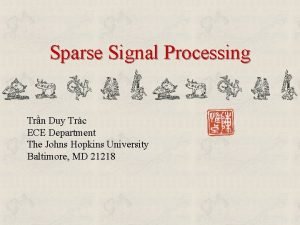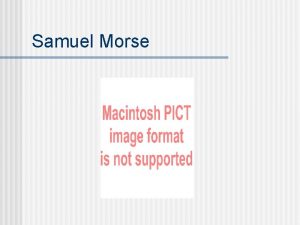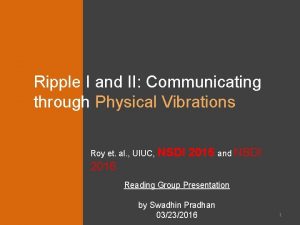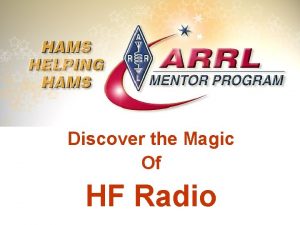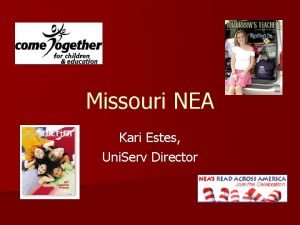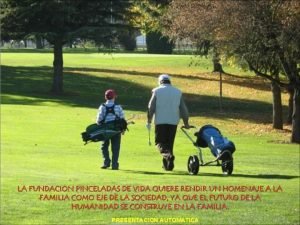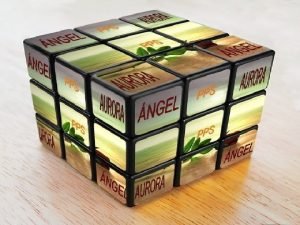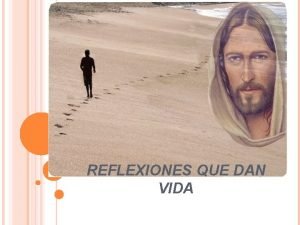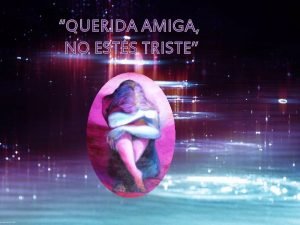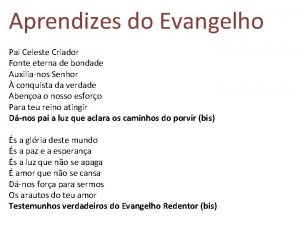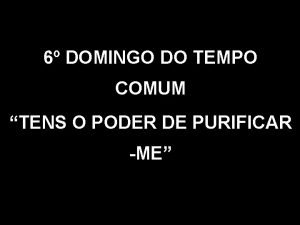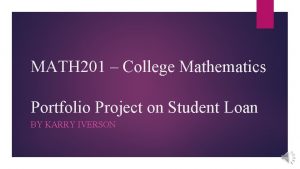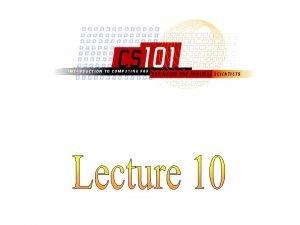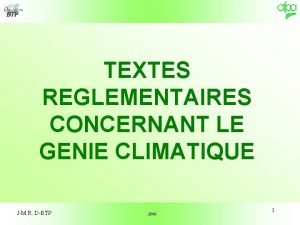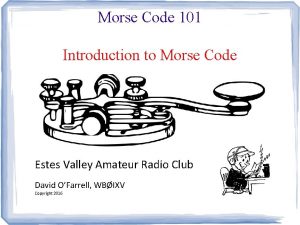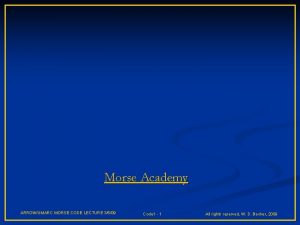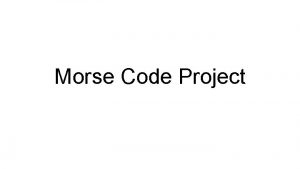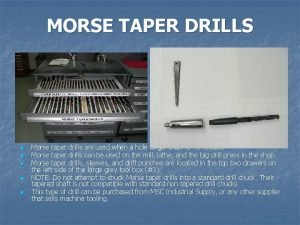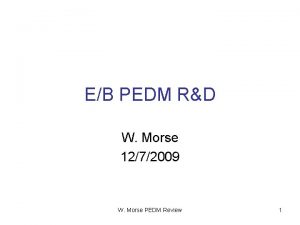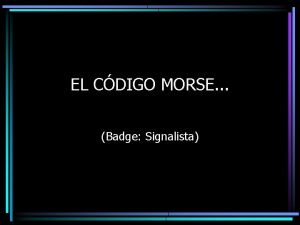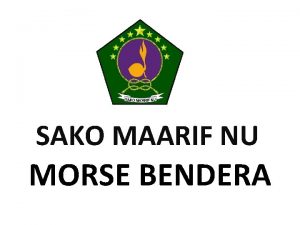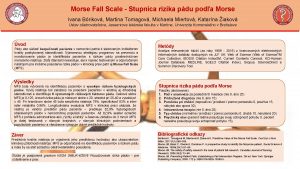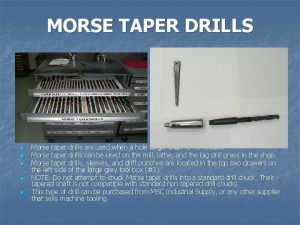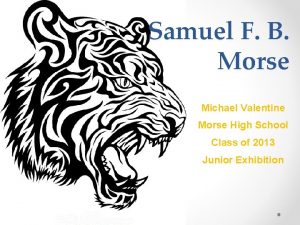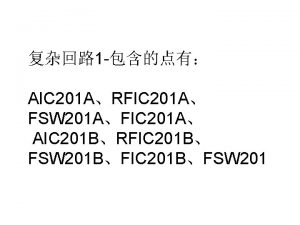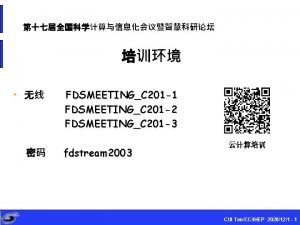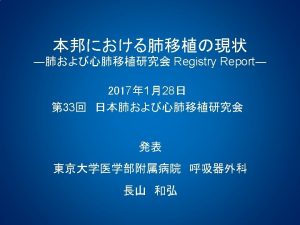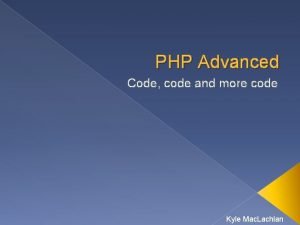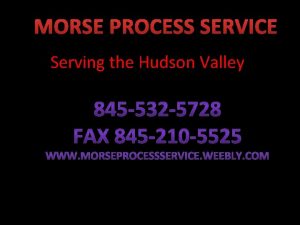Morse Code 201 MORSE and MORE Estes Valley













































- Slides: 45

Morse Code 201 MORSE and MORE! Estes Valley Amateur Radio Club David O’Farrell, WBØIXV Copyright 2016

● First It's MORSE CODE – NOT MORRIS CODE – Morris is a cat

● Samuel Fineley Breese Morse is given credit as the inventor of the telegraph and the code ● ● Alfred Vail was his Assistant:

What we will cover ● Some History – My Amateur and Commercial History – Brief History of Morse, Wire and Wireless ● How to improve your speed ● What’s a word? ● How much bandwidth is CW? ● Speed records ● Other Morse code languages

● My Amateur Radio History – First Licensed as a Novice in 1964, when I was 15 years old – KN 7 YXO ● – I upgraded to General Class in 1965 - WA 7 COH ● – That required a 5 wpm code test That required a 13 wpm code test from the FCC When I moved to Colorado in 1971, I was issued WBØIXV, and I am currently an Extra class operator

● My Commercial History – ● From 1965 to 1971 I was a telegrapher for the Northern Pacific Railway (later the Burlington Northern RR) on the Tacoma Division in Washington State. That required knowledge of American Morse Code

● Signaling using symbolism – Indian Smoke Signals – “One if by land, Two if by sea” – French semaphore signaling – – – 1790’s and after Relayed ever 6 miles All used pre-arranged signals ● Not a general method of signaling

● ● America's first telegram was sent by Morse on 6 January 1838 On May 24, 1844 he sent “What Hath God Wrought” from Baltimore to Washington, D. C. a distance of 40 miles.

● Originally printed on paper tape

● American Morse – Morse’s Original code – 20% faster than International Morse due to the internal spacing within elements – 11 Letters different, 9 numbers different – Some American Morse still used today: ● 30 = SK …-. - (end of work) ● FN = AR . -. -. ● & = ES . … (end of message)


● ● American Morse – use from the mid 1840's to 1985. International Morse – currently used only by Amateur Radio operators.

● Am I using Morse Code or CW? CW – Continuous Wave

● Amateur Radio Morse History – Prior to 1912 – No license needed! – Radio Act of 1912 – 5 wpm required; increased to 10 wpm by 1919 – Radio Act of 1927 – No change – Communications Act of 1934 ● Code speed of 13 wpm required after 1936

– Amateur tests from 1951: ● ● Novice & Technician test was 5 wpm –General test was 13 wpm – sending and receiving Extra test was 20 wpm – sending and receiving – Amateur code tests reduced to 5 wpm in 2000 – FCC eliminates code tests for amateurs in 2007

● FCC Commercial Radiotelegraph license - 2013 – Third, Second, First class radiotelegraph licenses eliminated – New Radiotelegraph Operators License (T) – Maritime Radio Historical Society gives the exam quarterly.

– Morse code not dead yet! ● December 2003, ITU adds new Morse character for @ COMMAT - ‘AC’

– Morse is the First DIGITAL mode ● ● CW is sent by either turning a carrier on or off, which is 2 states, so it qualifies as digital by that definition. It also qualifies under the binary definition, using only 1’s and 0’s Morse Code can be sent. – ● A 101110 It’s a digital mode with elements of unequal length.

● It can be done with Light or Sound. – It can be done with wigwag flags, blinker lights, horns, whistles, signal mirrors, or heliograph.

● The Morse Code Heliograph distance record is 183 miles (295 km) from Mount Ellen, UT to Mount Uncompahgre, CO by the U. S. Signal Corps, September 17, 1894.

● Sending Morse Code with a Straight Key – Telegrapher’s Glass Arm ● Known today as carpel tunnel syndrome

● Sending Morse Code – Bug (Semi-automatic key) Dates from 1906. Speed with this key is around 40 wpm

● Myth of Iambic Keying – Device Keystrokes – to send A-Z and 0 - 9 ● Straight Key 132 ● Semi-automatic Bug 87 ● Non-iambic Electronic Keyer 73 ● Iambic Electronic Keyer 65

● Four stages of Learning: – Unawareness of lack of knowledge – Conscious knowledge – Unawareness of knowledge

● ● Four Phases to become an Morse expert: – Hustling for the letters – Learning to hear words – Talking in several words, a phrase or short sentence – Becoming only conscious of the content Conscious effort is fatal to speed

● How to improve your speed – Listen for words instead of letters – Learn the most used words – Copy behind – Stop writing it down, copy in your head.



● Most used words: – the that with but – be have he his – to I as by – of it you from – and for do – they not at – in on this

● Copying one, two, or more characters behind. – Carry the letters in your mind – Goal to disengage your conscious attention – Work to make copying code done more by your subconscious mind.

● Copying behind exercise – Spell these words verbally = As you write the words am an as to so or on no my of me we us up at be do go he if in is

What is a word? How many letters make a word? Four or Five?

PARIS vs CODEX standard PARIS – Natural language word rate CODEX – Word rate for random letters

PARIS - The word PARIS is exactly 50 elements or dot units P = di da da di = 1 1 3 1 1 (3) = 14 elements A = di da = 1 1 3 (3) = 8 elements R = di da di = 1 1 3 1 1 (3) = 10 elements I = di di = 1 1 1 (3) = 6 elements S = di di di = 1 1 1 [7] = 12 elements Total = 50 elements

● CODEX (CODEZ) word standard – Using the word CODEX with 60 dot units

● PARIS vs. CODEX (CODEZ) word standard – For commercial radiotelegraph licenses

● CW Bandwidth – CW Bandwidth = wpm X 4 (e. g. , 40 WPM = 160 Hz) Or more precisely: CW Bandwidth = baud rate x wpm x fading factor

● Extra Info – Other versions of the code – Traffic handling – Code Speed Records

● Extra Info – Other versions of the code ● Arabic Greek ● Hebrew Japanese ● Korean Russian ● Thai Turkish

● Chinese Morse Code

● Extra Info – Traffic handling - NTS the National Traffic System ● Traffic Nets ● Traffic Procedures and Message Format – – Header, Preamble, Body, Signature Q signals ● QRV – I am ready to receive messages ● QN… - Additional Q signals

● Extra Info – Code Speed Records ● Copying (typewriter) Morse Code – ● Sending with Straight Key – ● Ted Mc. Elroy 75. 2 wpm perfect copy – July 2, 1939 Harry A. Turner, U. S. Army Signal Corps – 35 wpm – Nov. 9, 1942 Radio. Sport – High Speed Telegraphy (HST) – ‘marks’ – – – 300 letters per minute (60 wpm) 320 figures per minute (64 wpm) 230 mixed per minute (46 wpm)

● Extra Info – Key Collecting – Some hobbyists have huge key collections. ● Can collect straight keys ● Or, Vibroplex bugs ● Or, whatever

– J-38 Keys even have a following: ● American Radio Hardware – (ARH) ● American Radio & Telegraph Corp. (ARTEC) ● Mc. Elroy Mfg Corp ● Lionel Corp ● Radio Essentials (same as ARH) ● Cook Electric Co. ● Signal Electric Mfg. (SEMCO) ● Telegraph Apparatus Corp. (TAC)

● ● Contact info; – WBØIXV@arrl. net – 970. 577. 7372 Resources: – See handout – Morse Express 10691 E Bethany Dr, Suite 800 Aurora, CO 80014 USA
 More more more i want more more more more we praise you
More more more i want more more more more we praise you More more more i want more more more more we praise you
More more more i want more more more more we praise you Busceral
Busceral __-____--__ __-__ morse code
__-____--__ __-__ morse code Morse code ascii
Morse code ascii Morse code speed record
Morse code speed record Flowchart loop symbol
Flowchart loop symbol House of leaves code
House of leaves code Morse code binary tree
Morse code binary tree Morse code
Morse code Morse code translator
Morse code translator Morse code translator
Morse code translator Morse code rox
Morse code rox Pinscola
Pinscola Morse code numbers
Morse code numbers Morse code trn
Morse code trn Morse code trn
Morse code trn Samuel morse background
Samuel morse background Code morse
Code morse Affine cipher
Affine cipher Morse code
Morse code Morse code
Morse code Neakari
Neakari Hector ochoa cardenas
Hector ochoa cardenas Estes park parking
Estes park parking Cielo triste
Cielo triste Resolva estes sistemas pelo método da substituição
Resolva estes sistemas pelo método da substituição Cuando estes desanimado
Cuando estes desanimado Amiga tu dolor tambien es mi dolor
Amiga tu dolor tambien es mi dolor Richard estes
Richard estes Cuando estes triste busca a dios
Cuando estes triste busca a dios Musica pai celeste criador fonte eterna de bondade
Musica pai celeste criador fonte eterna de bondade Se a rocha que me abriga casa forte que me salva
Se a rocha que me abriga casa forte que me salva Human history becomes more and more a race
Human history becomes more and more a race Quail valley middle school dress code
Quail valley middle school dress code 5 apples in a basket riddle
5 apples in a basket riddle The more you study the more you learn
The more you study the more you learn Aspire not to have more but to be more
Aspire not to have more but to be more Define inertia
Define inertia Knowing more remembering more
Knowing more remembering more More love to thee o lord
More love to thee o lord More choices more chances
More choices more chances Math 201 bryant and stratton
Math 201 bryant and stratton Difference between source code and machine code
Difference between source code and machine code Code mixing examples
Code mixing examples Nf p 40-201
Nf p 40-201



